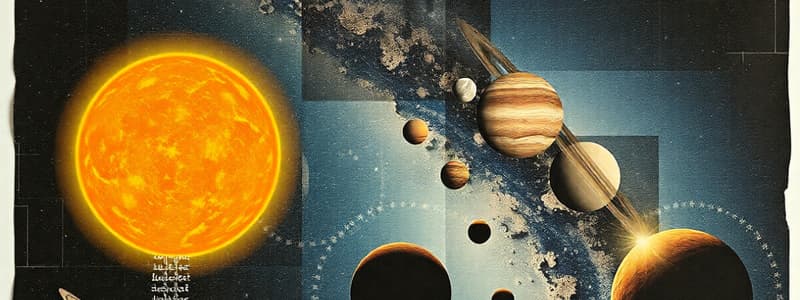Podcast
Questions and Answers
What is the average distance of 1 AU in kilometers?
What is the average distance of 1 AU in kilometers?
- 200 million km
- 150 million km (correct)
- 100 million km
- 250 million km
Which planet is not classified as a terrestrial planet?
Which planet is not classified as a terrestrial planet?
- Venus
- Uranus (correct)
- Earth
- Mars
What significant feature distinguishes Jovian planets from terrestrial planets?
What significant feature distinguishes Jovian planets from terrestrial planets?
- Composition primarily of rock and metal
- Smaller size and less mass
- Presence of rings made of ice and dust (correct)
- Higher density compared to terrestrial planets
Which of the following statements about Pluto is true?
Which of the following statements about Pluto is true?
Which galaxy is the Solar System located near?
Which galaxy is the Solar System located near?
What is one characteristic of terrestrial planets?
What is one characteristic of terrestrial planets?
What is the average shape of the Earth described as?
What is the average shape of the Earth described as?
What is the approximate mean radius of the Earth in kilometers?
What is the approximate mean radius of the Earth in kilometers?
How many planets are classified in the Solar System?
How many planets are classified in the Solar System?
Which of the following is not considered a dwarf planet?
Which of the following is not considered a dwarf planet?
Flashcards
Solar System
Solar System
The Sun and all objects that orbit it, including planets, moons, and asteroids
Inner Planets
Inner Planets
Rocky planets close to the Sun, with few, if any, moons
Outer Planets
Outer Planets
Gas giants farther from the Sun and have many moons and rings
Astronomical Unit (AU)
Astronomical Unit (AU)
Signup and view all the flashcards
Milky Way
Milky Way
Signup and view all the flashcards
Planet
Planet
Signup and view all the flashcards
Earth's shape
Earth's shape
Signup and view all the flashcards
Earth's mean radius
Earth's mean radius
Signup and view all the flashcards
Pluto's status change
Pluto's status change
Signup and view all the flashcards
Galaxy
Galaxy
Signup and view all the flashcards
Study Notes
Our Solar System
- Composed of the Sun and objects orbiting it (planets, moons, etc.)
- Located near the edge of the Milky Way galaxy
- The Milky Way is a large, disk-shaped galaxy
- Galaxies are groups of stars held together by gravity
- Galaxies vary in size, shape, and density
Solar System Details
- AU (Astronomical Unit): Average distance between Earth and Sun (approximately 150 million km)
- The Sun contains 99% of the solar system's mass
Planets
-
Spherical objects orbiting the Sun
-
Orbit on a specific path
-
Eight planets in our solar system, divided into inner and outer
-
Inner Planets (terrestrial planets):
- Primarily made of rock and metal
- Smaller in size
- Few or no rings
- Few or no moons
- Examples include Mercury, Venus, Earth, and Mars
-
Outer Planets (Jovian or gas giants):
- Mostly made of hydrogen and helium
- Larger in size
- Have many rings and moons
- Examples include Jupiter, Saturn, Uranus, and Neptune
Earth's Properties
- Shape: Oblate spheroid (slightly flattened at the poles)
- Mean radius: 6,371 km
- Circumference at the equator: 40,075 km
Studying That Suits You
Use AI to generate personalized quizzes and flashcards to suit your learning preferences.




